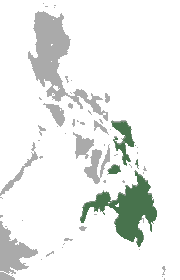
Geoffroy's rousette is a species of megabat or Old World fruit bats. It is one of ten species in the genus Rousettus.

Andersen's fruit-eating bat is a bat species found in South America.
Aethalops is a genus of megabats in the family Pteropodidae. It contains two species:

Rüppell's or the greater broad-nosed bat is a species of vespertilionid microbat found in eastern Australia.

The Peters's epauletted fruit bat is a species of megabat in the family Pteropodidae. It is found in Angola, Botswana, Democratic Republic of the Congo, Eswatini, Malawi, Mozambique, Namibia, Tanzania, Zambia, and Zimbabwe. Its natural habitat is in riverine or evergreen forest, or moist woodland, where there are fruit-bearing trees.

The harpy fruit bat is a species of megabat in the family Pteropodidae. It is endemic to the Philippines.

The Philippine forest roundleaf bat is a species of bat in the family Hipposideridae. It is endemic to the Philippines.

Sorensen's leaf-nosed bat is a species of bat in the family Hipposideridae that is endemic to Indonesia.

Ptenochirus is a genus of bat in the family Pteropodidae. It contains the following species:

The lesser musky fruit bat is a species of megabat in the family Pteropodidae. It is endemic to the Philippines.

The great flying fox, also known as the greater flying fox or Bismarck flying fox, is a species of megabat in the genus Pteropus, found throughout lowland areas of New Guinea and in the Bismarck Archipelago. Conflicting evidence suggests that its closest relative is either the spectacled flying fox or, jointly, the Pelew and insular flying foxes. Two subspecies are recognized. At up to 1.6 kg (3.5 lb) in weight, it is among the heaviest bats in the world and the largest bat in Melanesia. It is a gregarious animal which roosts with hundreds or thousands of individuals. In part due to its wide variation in color, it has many taxonomic synonyms, including Pteropus degener, Pteropus papuanus, and Pteropus sepikensis. It may forage during the day or night in search of fruit, including figs or fruits from the family Sapotaceae. It is considered a least-concern species by the IUCN, though its numbers have been negatively impacted by what appeared to be a disease, as well as by hunting for bushmeat that occurs across its range.

The large flying fox, also known as the greater flying fox, Malayan flying fox, Malaysian flying fox, large fruit bat, kalang, or kalong, is a southeast Asian species of megabat in the family Pteropodidae. Despite its scientific name, it feeds exclusively on fruits, nectar, and flowers, like the other flying foxes of the genus Pteropus. It is noted for being one of the largest bats. As with nearly all other Old World fruit bats, it lacks the ability to echolocate but compensates for it with well-developed eyesight.

The acuminate horseshoe bat is a species of bat in the family Rhinolophidae. It is found in Southeast Asia. It lives in forests and urban areas.

The arcuate horseshoe bat is a species of bat in the family Rhinolophidae. It is found in Indonesia, Malaysia, Papua New Guinea, and the Philippines.

Blasius's horseshoe bat is a species of insectivorous bat in the family Rhinolophidae found throughout large parts of the Mediterranean, Middle East and Africa.

The Bornean horseshoe bat is a species of bat in the family Rhinolophidae. It is found in Brunei, Cambodia, Indonesia, Laos, Malaysia, and Vietnam.

The Borneo fruit bat is a species of megabat found in the mountains of Borneo, specifically East Malaysia and Brunei. It is considered a subspecies of Aethalops alecto by some authors.

The lesser short-nosed fruit bat is a species of megabat within the family Pteropodidae. It is a small bat that lives in South Asia and Southeast Asia. It weighs between 21 and 32 grams, and measures 70 to 127 millimetres. It occurs in many types of habitat, but most frequently in disturbed forest, including lower montane forest and tropical lowland rain forest, plus gardens, mangroves, and vegetation on beaches.

Andersen's naked-backed fruit bat or Andersen's bare-backed fruit bat is a large cave-dwelling species of megabat in the family Pteropodidae. It is endemic to the Bismarck Archipelago including the Admiralty Islands in Papua New Guinea.

Andreas Fedor Jagor was a German ethnologist, naturalist and explorer who traveled throughout Asia in the second half of the 19th century collecting for Berlin museums.




















